-
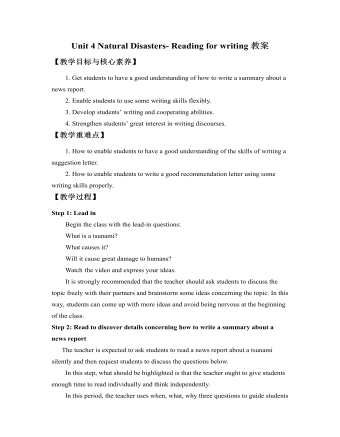
新人教版高中英语必修1Unit 4 Natural Disasters- Reading for writing教案
①标题——标题应当简洁明了。②导语——导语是消息开头的第一段或第一句话,简明扼要地揭示出消息的核心内容。③主体——主体是消息的主要部分,要用充足的事实表现主题,对导语的内容作进一步的展开和阐述。④结束语——通常是对全文内容进行概括性的总结。3. 新闻报道增分句子(1)陈述事实常用的句型:①A terrible storm hit/struck ... , killing ..②It was a cool autumn night when the earthquake happened. A large number of buildings fell down and roads were destroyed, leaving a great many people homeless.地震发生在一个凉爽的秋夜。大量的建筑物倒塌,道路被毁,许多人无家可归。③With the help of the rescue team, people who were the trapped in the flood were saved.在救援队的帮助下,困在洪水中的人们得救了。(2)陈述观点常用的句型:①Clearly/Obviously/In my opinion/It seemed that people were shocked.显然/在我看来/似乎人们震惊了。②The whole city was in ruins after the earthquake.地震后整个城市成了一片废墟。(3)揭示原因常用的句型:Because of/As a result of/Thanks to the help of the army, people who got injured were sent to the hospital immediately.
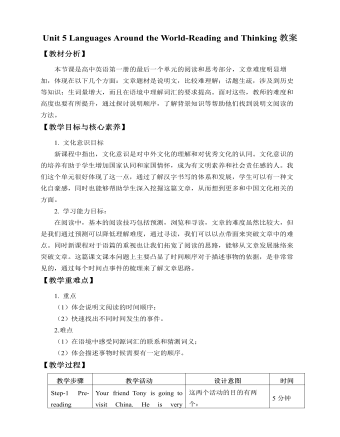
新人教版高中英语必修1Unit 5 Languages Around the World-Reading and Thinking教案
【教材分析】本节课是高中英语第一册的最后一个单元的阅读和思考部分,文章难度明显增加,体现在以下几个方面:文章题材是说明文,比较难理解;话题生疏,涉及到历史等知识;生词量增大,而且在语境中理解词汇的要求提高。面对这些,教师的难度和高度也要有所提升,通过探讨说明顺序,了解背景知识等帮助他们找到说明文阅读的方法。【教学目标与核心素养】1. 文化意识目标新课程中指出,文化意识是对中外文化的理解和对优秀文化的认同。文化意识的的培养有助于学生增加国家认同和家国情怀,成为有文明素养和社会责任感的人。我们这个单元很好体现了这一点,通过了解汉字书写的体系和发展,学生可以有一种文化自豪感,同时也能够帮助学生深入挖掘这篇文章,从而想到更多和中国文化相关的方面。2. 学习能力目标

新人教版高中英语必修2Unit 1 Cultural Heritage-Listening&Speaking&Talking教案
Listening and Speaking introduces the topic of “Take part in a youth project”. The listening text is an interview about an international youth cultural heritage protection project. More than 20 high school students from seven countries participated in the project. The reporter interviewed two participants Stephanie and Liu Bin. By listening to the text, students can understand the significance of cultural heritage protection, and teenagers can use their knowledge, combine their own interests and advantages, etc. to participate in the action of cultural heritage protection. Listening and Talking introduces the theme of "Talk about history and culture". The listening text is a dialogue between two tourists and tour guides when they visit the Kremlin, red square and surrounding buildings. The dialogue focuses on the functional items of "starting a conversation", which is used to politely and appropriately attract the attention of the others, so as to smoothly start a conversation or start a new topic. The purpose of this section is to guide students to understand the history and current situation of Chinese and foreign cultural heritage in their own tourism experiences or from other people's tourism experiences, explore the historical and cultural values, and be able to express accurately and appropriately in oral communication.1. Guide students to understand the content of listening texts in terms of the whole and key details; 2. Cultivate students' ability to guess the meaning of words in listening; discuss with their peers how to participate in cultural heritage protection activities.3. Instruct students to use functional sentences of the dialogue such as “I beg your pardon, but…” “Forgive me for asking, but…" and so on to start the conversation more politely and appropriately.
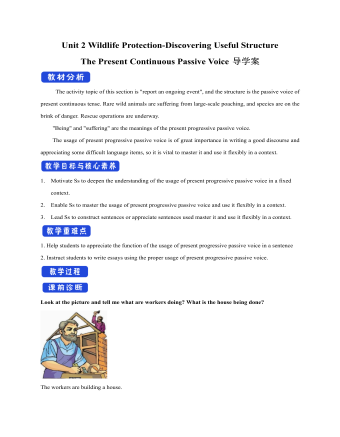
新人教版高中英语必修2Unit 2 Wildlife Protection-Discovering Useful Structure教案一
The activity topic of this section is "report an ongoing event", and the structure is the passive voice of present continuous tense. Rare wild animals are suffering from large-scale poaching, and species are on the brink of danger. Rescue operations are underway. "Being" and "suffering" are the meanings of the present progressive passive voice.The usage of present progressive passive voice is of great importance in writing a good discourse and appreciating some difficult language items, so it is vital to master it and use it flexibly in a context.1. Motivate Ss to deepen the understanding of the usage of present progressive passive voice in a fixed context.2. Enable Ss to master the usage of present progressive passive voice and use it flexibly in a context.3. Lead Ss to construct sentences or appreciate sentences used master it and use it flexibly in a context.1. Help students to appreciate the function of the usage of present progressive passive voice in a sentence2. Instruct students to write essays using the proper usage of present progressive passive voice.Look at the picture and tell me what are workers doing? What is the house being done?
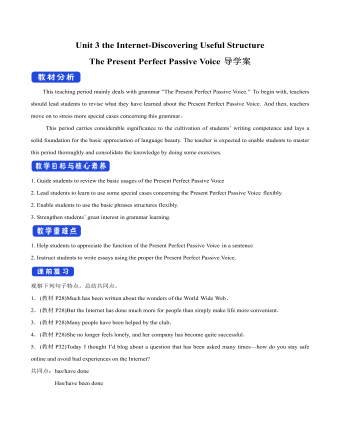
新人教版高中英语必修2Unit 3 The Internet-Discovering Useful Structure教案二
This teaching period mainly deals with grammar “The Present Perfect Passive Voice.” To begin with, teachers should lead students to revise what they have learned about the Present Perfect Passive Voice. And then, teachers move on to stress more special cases concerning this grammar。This period carries considerable significance to the cultivation of students’ writing competence and lays a solid foundation for the basic appreciation of language beauty. The teacher is expected to enable students to master this period thoroughly and consolidate the knowledge by doing some exercises. 1. Guide students to review the basic usages of the Present Perfect Passive Voice2. Lead students to learn to use some special cases concerning the Present Perfect Passive Voice flexibly.2. Enable students to use the basic phrases structures flexibly.3. Strengthen students’ great interest in grammar learning.1. Help students to appreciate the function of the Present Perfect Passive Voice in a sentence2. Instruct students to write essays using the proper the Present Perfect Passive Voice.观察下列句子特点,总结共同点。1.(教材P28)Much has been written about the wonders of the World Wide Web.2.(教材P28)But the Internet has done much more for people than simply make life more convenient.3.(教材P28)Many people have been helped by the club.4.(教材P28)She no longer feels lonely, and her company has become quite successful.5.(教材P32)Today I thought I’d blog about a question that has been asked many times—how do you stay safe online and avoid bad experiences on the Internet?
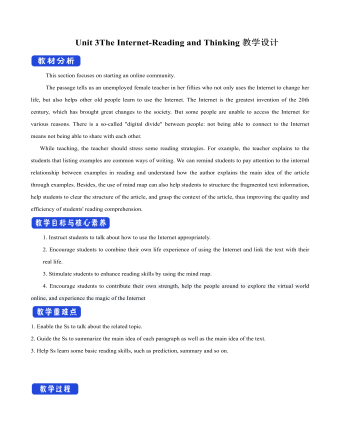
新人教版高中英语必修2Unit 3 The Internet-Reading and Thinking教案一
Paragraph 3. Jan decided to start an IT club to teach old people how to use computers and the Internet. Paragraph 4. Jan has started taking online classes to learn more about how to use the Internet to make society better. Paragraph 5. Jan’s life has been greatly improved by the Internet. Step 5: Critical thinking:(1)How do you arrange your time spent on study and the Internet? Is it reasonable? I usually surf the Internet using my mobile phone for only an hour after class, and it is reasonable for me.(2)What are your online activities? Are they safe? I chat with my friends, read news and play games. I never give away my private information so I think they are safe.Step 4: summary Much has been written about the wonders of the World Wide Web. There are countless articles (1)______(tell) us how the Internet has made our lives more convenient. But the Internet has done a lot (2)_____(much) for people than simply make life more convenient. People’s lives (3) _________________(change) by online communities and social networks so far. Take Jan for example, who developed a serious illness that made her (4)_____(stick) at home with only her computer to keep (5)___(she) company. She joined an online group (6)______ she could share problems, support and advice with others. She considered the ability to remove the distance between people as one of the greatest (7)_______(benefit). She was so inspired (8)____ she started an IT club in which many people have been helped. She has started to learn more about how to use the Internet to make society better. Her next goal is to start a charity website to raise money (9)___ children in poor countries. Jan’s life has been (10)______(great) improved by the Internet. Step 5 Homework:Review what we have learned and find out the key language points in the text.

新人教版高中英语必修2Unit 4 History and Traditions-Listening&Speaking&Talking教案二
Listening and Speaking introduces the topic of “Take part in a youth project”. The listening text is an interview about "sharing views on historical sites". Through listening to a dialogue between Chinese and foreign students on the way to the Confucius Temple, students can understand their views on the Confucius Temple, Confucius, Confucius' descendants and Confucius' educational thoughts, so as to realize and think about the profound influence of Confucius and his thoughts on Chinese historical tradition. At the same time, the dialogue naturally integrates English idioms and mentions Shakespeare, the British playwright, so as to provide language materials and context for students to understand English idioms and related cultural allusions, as well as to compare Chinese and foreign cultures, which is helpful for students to understand and express the language such as history, tradition, culture and custom significant impact.Text analysis: listening text is a dialogue between a British student and a Chinese student when he goes to the Confucius Temple. When William, a British student, visited the Confucius Temple, he asked Xiao Kong, a Chinese student, for directions. Xiao Kong was just going to the Confucius Temple to meet with the members of the research group, so they went together and exchanged their views on the Confucius Temple, Confucius, Confucius' descendants and Confucius' educational thoughts. From the perspective of foreign tourists, this paper describes their thoughts on Confucius, the great son of Confucius, who had a profound impact on Chinese history and cultural tradition, and his education.Listening and Talking introduces a visit to a historic tourist destination. Tourism is a common way to understand a country's history, culture, and customs and so on. Students listen to the dialogue between Xiao Yan, a youth hostel Usher, and Paul, a backpacker, to learn about Pingyao's famous historical and cultural attractions and Paul's travel experience and experience as a foreign tourist.

新人教版高中英语必修2Unit 5 Music-Discovering Useful Structures教案一
Step1:自主探究。1.(教材P52)Born(bear) in the USA on 2 January 1970, Whitacre began studying music at the University of Nevada in 1988.2.(教材P52) Moved(move) by this music, he said, “It was like seeing color for the first time.”3.(教材P56)I was very afraid and I felt so alone and discouraged(discourage).4.(教材P58)Encouraged(encourage) by this first performance and the positive reaction of the audience, I have continued to play the piano and enjoy it more every day.Step2:语法要点精析。用法1:过去分词作表语1).过去分词可放在连系动词be, get, feel, remain, seem, look, become等之后作表语,表示主语所处的状态Tom was astonished to see a snake moving across the floor.汤姆很惊讶地看到一条蛇正爬过地板。Finally the baby felt tired of playing with those toys.终于婴儿厌倦了玩那些玩具。注意:1).过去分词作表语时与被动语态的区别过去分词作表语时,强调主语所处的状态;而动词的被动语态表示主语是动作的承受者,强调动作。The library is now closed.(状态)图书馆现在关闭了。The cup was broken by my little sister yesterday.(动作)昨天我妹妹把杯子打碎了。2)感觉类及物动词的现在分词与过去分词作表语的区别过去分词作表语多表示人自身的感受或事物自身的状态,常译作“感到……的”;现在分词多表示事物具有的特性,常译作“令人……的”。
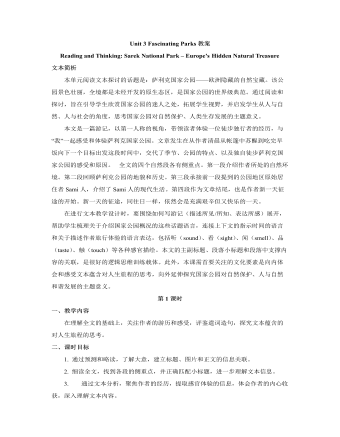
新人教版高中英语选修1Unit 3 Fascinating Parks教案
2. Explore the significance of the establishment of Sarek National Park.Q1: Which event is the most important one in the park’s history?Ss: The establishment of Sarek national park in 1909 is the most important one.Q2: Is it worth making a place like Sarek a national park? Give your reasons.Ss: Yes. In this way, the place can be kept in its natural state and natural beauties and other rare and valuable resources can be preserved instead of being destroyed by endless exploitation driven by profits.Q3: How does the writer organize his introduction to the history of Sarek?Ss: The writer organizes his introduction in the sequence of time, using time indicators such as “used to”, “around 9,000 years ago”, “soon after”, “following the reindeer”, and “in 1909”.Q4: What is the feature of the language used to introduce the history of the park?Ss: The introduction to the park is to provide facts, using time indicators to organize the events. Sentences starts with “third person” and passive voice is used more often, feeling objective.【设计意图】学生寻找和梳理公园历史上的重要事件,体会人与自然的和谐关系,评鉴介绍性语言的特点。【核心素养提升点】发展自主提取、梳理文本信息能力,训练逻辑思维和高阶思维。Activity 3: Highlighting the secret of the text
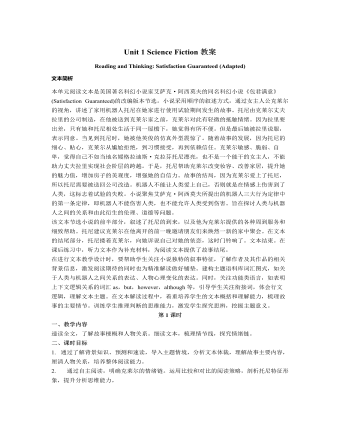
新人教版高中英语选修4Unit 1 Science Fiction教案
本活动旨在落实课时教学目标2。 1.Think, discuss and share. Students form groups of 4, discuss about the given ending make comments. Q1: Do you like the ending? Q2: Was it a logical ending? Why so or why not? [设计意图]通过引导学生思考、讨论、评价,比较个人、同伴所预测的结局和听力文本所给定的结局的异同点,深化对文本的认知,发展学生的评判性思维能力。 Activity 4: Exploring Asimov’s three laws of robotics and the purpose of the writing 本活动旨在落实课时教学目标3。 1. Get to know Isaac Asimov’s three laws of robotics. The teacher shares Isaac Asimov’s three laws of robotics. The three laws state that: ①A robot may not injure a human being or, through inaction, allow a human being to come to harm. ②A robot must obey any orders given to it by human beings, except where such orders would conflict with the First Law. ③A robot must protect its own existence as long as such protection does not conflict with the First or Second Law. Q: How does Tony’s story relate to the laws? 2. Figure out Isaac Asimov’s purpose of writing Satisfaction Guaranteed. The students express their opinions about the author’s writing purpose. Q: Why did Isaac Asimov write such a story? S: To explore the relationship between robots and humans. [设计意图]通过了解艾萨克·阿西莫夫所制定的机器人三大定律,加深学生对文本的理解,深入探究文本的主题意义。推理作者的写作目的,联系生活实际,思考人类与机器人的关系。
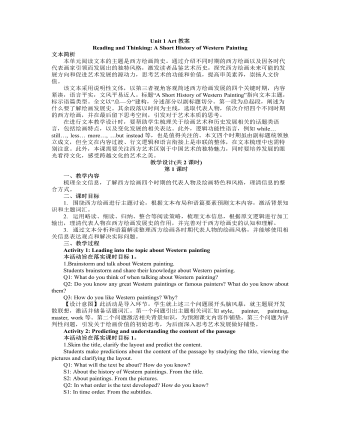
新人教版高中英语选修3Unit 1 Art教案
[2] An important breakthrough…was… [3] Another innovation was … [4] the emphasis increasingly shifted from…to… [5] New ideas and values gradually replaced… [6] While his paintings still had religious themes… … T: All these expressions serve to show how Western painting has developed. Some of them share similar structure but with varied use of words, which makes the text vivid and more readable. 【设计意图】主题类语言整理有助于学生类化语言应用,提高语言输出的丰富性。处理完文本内容信息后,进入语篇信息处理,进行主题相关的词块归类。引导学生快速阅读,寻找表达相同主题(发展或者艺术)的词和短语,再根据词性、用法和结构进行归类,储备主题相关词汇,丰富语言储备,提升语言素养。 Assignment: Go online to gather more information about Chinese painting and write a short history of it. 【设计意图】结合所学,迁移运用,根据实际语境,进行模仿性运用。在此过程中,学生尝试借鉴已学的语言、内容、语篇结构和写作手法来建构新文本,实现语篇输出,同时关注中西艺术文化的差别,加深对优秀文化的认同,培养文化意识。
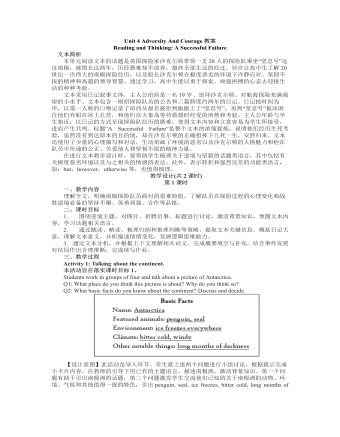
新人教版高中英语选修3Unit 4 Adversity And Courage教案
本活动旨在落实课时目标3。 The Student Union is looking for three students for a 3-week voluntary program in Guizhou province. The volunteers have got to be high school students, with a persevering personality and experiences in overcoming adversity. The volunteers need to stay, eat and teach with 20 pupils in a small school up on the hill of a village. There are no facilities but desks and a blackboard in the school. And there is no take-away food to be bought anywhere; the only way to feed yourself is to cook. You’re interested in applying. Write your application letter introducing what adversity you have ever overcome and how persevering you are as well as what you want to do when at work. Dear Student Union,【设计意图】此任务旨在迁移一、二课时所学,解决实际问题。学生对比自己经历过的挑战或挫折,写信给学生会申请前往贵州担任短期支教教师,把个人以前是怎么战胜挫折的经过书写出来。结合所学,迁移创新,分析解决自身实际问题,在真实情境中学生通过仿写进行主题语言的精确输出。完成任务的过程中,能较多地使用已学语言、内容、结构和写作手法来描述自己面对挫折的处理方式、态度和应有的品质,近一步激发学生树立正确的价值观,学会逆境出人才,坚忍不拔,从容不迫,又做到谦让、分享和合作。课后学生修正习作,再次提交。

《千人糕》教案
一、谈话导入师:同学们,中国有句俗话叫“民以食为天”,你们喜欢美食吗?(喜欢)老师也喜欢吃,不过我们可别光顾着吃,我们要认识它,还要记住他们的名字。(课件出示米糕图片)。1、师:看,老师给你们带来了什么?(米糕)生活中,你们除了吃过米糕,还吃过什么糕呢?(课件出示词语:蛋糕、雪糕、糕点。)领读词语。2、师:不论是蛋糕、雪糕,还是糕点,味道上都有一个共同点是()?甜,是因为在里面加入了糖,(出示糖的卡片认读生字“糖”)课件出示生活中常见的糖的图片,齐读词语。3、引导观察生字“糕、糖”,发现共同点,引出“粉”。交流“粉”的识字方法,引出“芬、份、纷、扮”,出示词语:粉丝、粉笔、面粉。齐读。
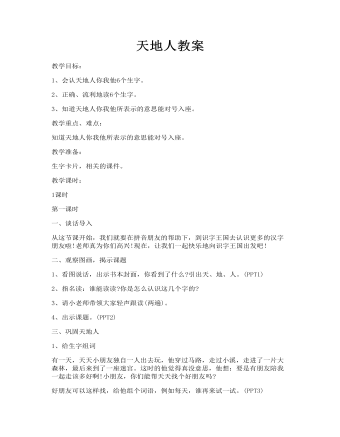
天地人教案
一、谈话导入从这节课开始,我们就要在拼音朋友的帮助下,到识字王国去认识更多的汉字朋友啦!老师真为你们高兴!现在,让我们一起快乐地向识字王国出发吧!二、观察图画,揭示课题1、看图说话,出示书本封面,你看到了什么?引出天、地、人。(PPT1)2、指名读:谁能读读?你是怎么认识这几个字的?3、请小老师带领大家轻声跟读(两遍)。4、出示课题。(PPT2)

人教部编版七年级语文上册狼教案
(学生交流,教师引导,总结方法)(1)方法1:主谓之间要停顿。【示例】一狼/得骨/止;其一/犬坐于前。(2)方法2 :谓语与宾语之间要停顿。【示例】顾/野有麦场;乃悟/前狼/假寐 。(3)方法3:连词前面可以停顿。【示例】后狼止/而前狼又至;意将/隧入/以攻其后也。(4)方法4 :发语词后面要停顿。【示例】盖/以诱敌。(全班齐读课文,读顺文章)师小结:理解文意,固然可以运用停顿技巧,但最重要的方法是弄懂字词大意、文句意思。理解了文意,才能读准句读,有利于我们读顺文章。【设计意图】本环节旨在通过学习互助的方式,调动学生的学习热情,充分发挥学生的学习积极性和主动性,进而理解文意,读顺文章。教师及时点拨,适时归纳文言释词方法、句式和停顿划分小技巧,实现知识学习与技能掌握的统一。四、细读课文,读懂内容1.概括文章情节文章讲述了屠户杀狼的故事。按照事件的发展,情节一般可以分为开端(发生)、发展、高潮和结局。请同学们细读课文后,用词语概括这个故事的发展经过。(生交流后,师明确)
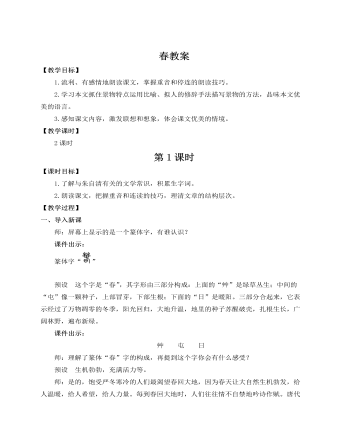
人教部编版七年级语文上册春教案
本文具有很强的画面感,凸显出绘画美,虽是散文,却满贮诗意,正是文中有画,画中有诗。作者从色泽、层次和动态上向人们展示了一幅栩栩如生的春景图。作者笔下的春景图色泽鲜艳,不仅有象征希望的“嫩嫩的,绿绿的”小草,还有“红的像火,粉的像霞,白的像雪”的繁花,也有温暖的“红红的”太阳的脸和“黄晕的”灯光,这些色彩描绘出了一个生机勃勃而又安静祥和的春天。在描写春景的时候,作者还通过有层次感的描写使景物意蕴悠长,例如对春雨的描写是从“人家屋顶上”到“小路上”“石桥边”再到“地里”,从远至近,层次分明。另外,朱自清使用精妙的语言向读者展示了动态(生机)美,在他笔下,花是“赶趟儿”的,蜜蜂是“闹着”的,气味儿是“酝酿”的,一切都是“生长着”的,洋溢着盎然的生机。作者从总体上描绘春景,大地回春、万物复苏的景象就活生生地展现在了读者眼前。

人教部编版七年级语文上册猫教案
【设计意图】此环节聚焦第三只猫的悲剧,让学生通过品析语言,想象猫的内心冤屈,同时结合创作背景,逐层深入地理解课文主题及作者的人文情怀。三、拓展延伸1.同学们,你喜欢文中哪一只猫呢?为什么?(生自由讨论)预设(1)喜欢第一只或第二只猫,因为它好看,性情可爱、活泼。(2)喜欢第三只猫,它更可怜,更需要关爱。(3)都喜欢,因为生命不分高低贵贱,它们是平等的。我们要尊重每一个生命。2.如果你是第三只猫,应该怎么做才能避免悲剧的发生呢?(分组讨论,全班交流。可从“自省”“自强”“完善自我”等角度讨论)预设(1)如果我是第三只猫,首先要自我反省,知道自己哪些方面不够优秀,找到不足,然后不断努力,完善自我。(2)不能埋怨别人,不能自甘堕落,不能放弃自己。结束语:文章以“我家养了好几次猫,结局总是失踪或死亡”总领全文,以“自此,我家永不养猫”收束全文,结构紧凑。文章以猫写人,用猫的世界折射世态人情。
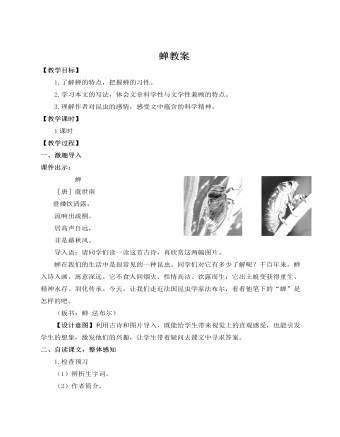
人教部编版语文八年级上册蝉教案
鲁迅曾把《昆虫记》称为“讲昆虫的故事”“讲昆虫生活”的楷模。鲁迅说:“他的著作还有两种缺点:一是嗤笑解剖学家,二是用人类道德于昆虫界。”周作人说:“法布尔的书中所讲的是昆虫的生活,但我们读了却觉得比看那些无聊的小说戏剧更有趣味,更有意义。”巴金说:“《昆虫记》融作者毕生的研究成果和人生感悟于一炉,以人性观照虫性,将昆虫世界化作供人类获取知识、趣味、美感和思想的美文。”传统文化玉蝉:蝉意喻人生蝉在古人的心目中地位很高,向来被视为纯洁、清高、通灵的象征。玉蝉究其用途,大体可分为四种:一是佩蝉,是专门佩戴在人身上以作装饰和避邪用,示高洁;一种为冠蝉,是作为饰物缀于帽子上的,表示高贵;一种是琀蝉,以蝉的羽化比喻人能重生,寓指精神不死,再生复活;还有一种是镇蝉,做镇纸用的文房用品,多出现在明代以后,前三种蝉属于高古玉,主要产生在商周至战汉时期。

高一语文衔接课教案
一、心态调整。 首先,熟知盲点。即了解初高中语文课标的要求差异及变化,做到心中有数,明确衔接过渡的着力点。初、高中语文,考查的重点基本上聚焦在文言文阅读、现代文阅读、诗歌鉴赏、语言运用和作文这五个方面。与初中语文相比,高中语文学习的难度明显在增加了。其具体变化情况简要归类如下: ①语法修辞进考查要求。初中对语法、修辞、文言文词法、句法等知识,侧重于了解,教学中淡化且不作为考查内容;而在高中则重在运用,对语言知识的要求较高,教学中强化且作为重要的考查内容。 ②诗歌阅读增加了难度。从初中的了解到高中的学习,从初中的重在考查积累,到高中强化理解分析,体现了初高中诗歌学习的变化。
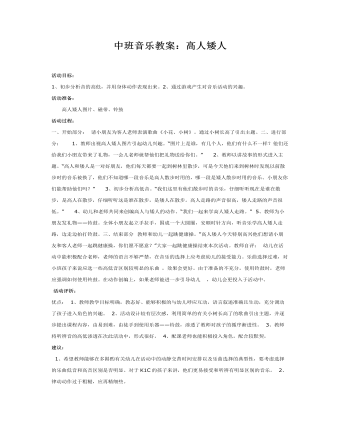
中班音乐教案:高人矮人
活动过程:一、开始部分: 请小朋友为客人老师表演歌曲《小花、小树》。通过小树长高了引出主题。二、进行部分: 1、教师出视高人矮人图片引起幼儿兴趣。“图片上是谁,有几个人,他们有什么不一样?他们还给我们小朋友带来了礼物,一会儿老师就帮他们把礼物送给你们。”2、教师以讲故事的形式进入主题。“高人和矮人是一对好朋友,他们每天都要一起到树林里散步,可是今天他们来到树林时发现以前散步时的音乐被换了,他们不知道哪一段音乐是高人散步时用的,哪一段是矮人散步时用的音乐。小朋友你们能帮助他们吗?”3、初步分析高低音。“我们这里有他们散步时的音乐,仔细听听现在是谁在散步,是高人在散步,仔细听听这是谁在散步,是矮人在散步。高人走路的声音很高,矮人走路的声音很低。





















